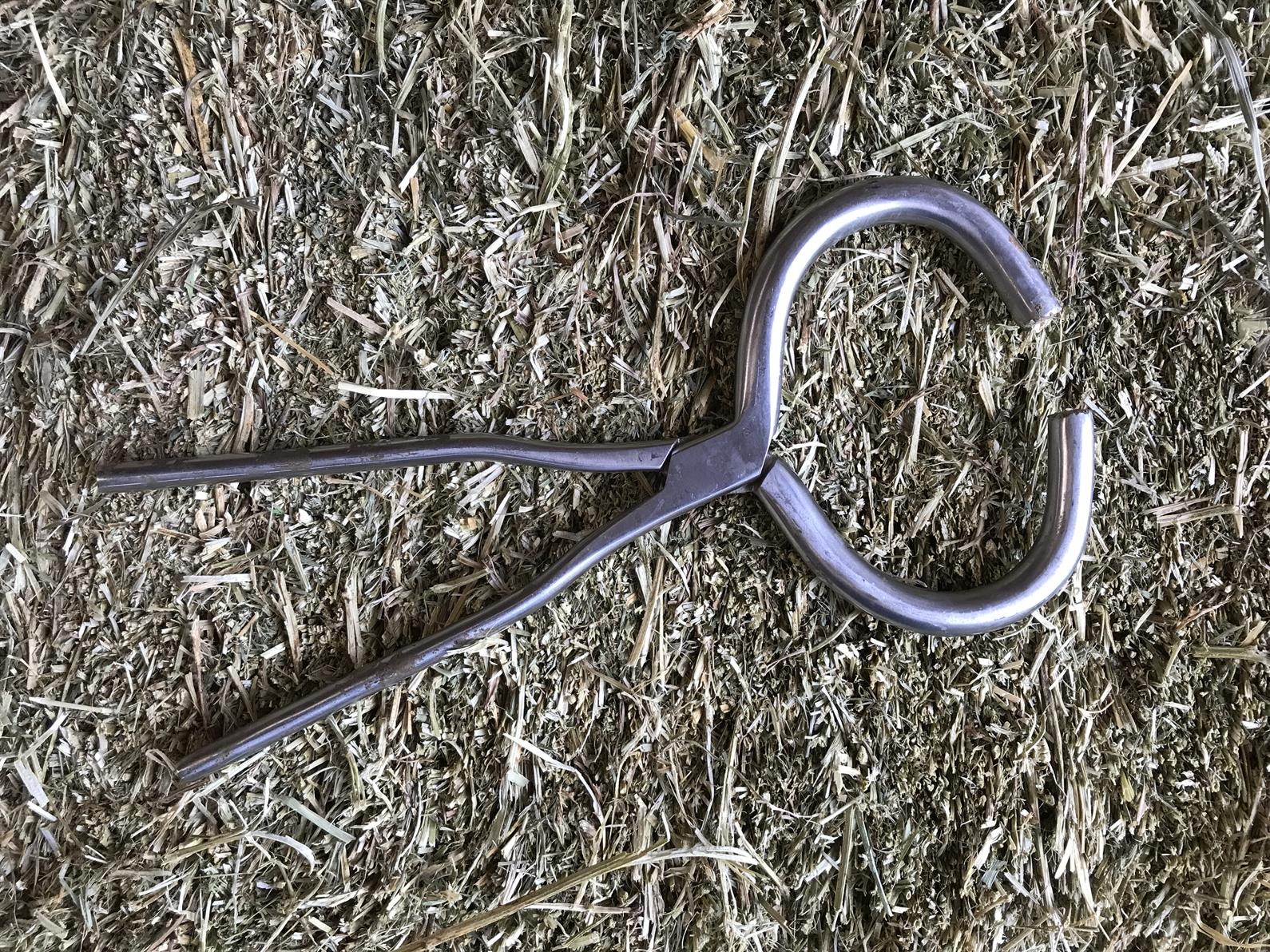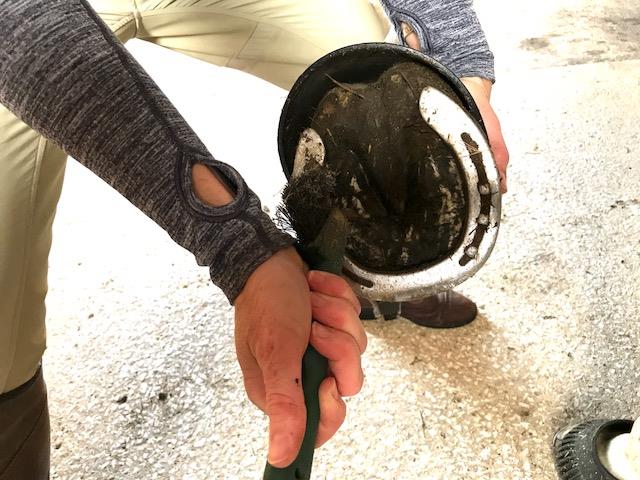Hoof abscesses can be painful for your mount and cost you time in the saddle. We asked Dr. Luke Fallon of Hagyard Equine Medical Institute for his best tips about dealing with hoof abscesses, including identifying, treating, and avoiding them. Read on to find out the signs that distinguish an abscess from another problem, what to put in your hoof-soaking solution, and what management techniques can help reduce your horse’s chance of getting a hoof abscess.
A hoof abscess can look terrifying to a horse owner, because it can cause severe lameness that appears to come on suddenly. To a worried owner who finds a horse or pony three-legged lame in his pasture, that can look extremely serious.
“A horse with a foot abscess can look like he’s got a fractured leg,” said Fallon. “Sometimes, if it’s in a hind leg, it’s hard to determine whether it’s in the foot or up higher—in the stifle or hip region—because often they’ll show the same sort of lameness. In a front leg, a lot of times you can tell if it’s a hoof abscess by whether the horse is willing to flex or extend the fetlock joint, the carpus (knee) joint, and the elbow and shoulder. If they have any decreased range of motion or pain associated with manipulation of the upper joints, from the fetlock up through the shoulder, you may well have a lameness that is not caused by the foot.
“Abscesses are quite often associated with changes in the moisture content in the soil or environment,” Fallon added. “The white line along the solar surface of the hoof wall will open and close, and the quality of the periople—the waxy hoof coating that extends down from the coronet band and is similar to the cuticle on a human fingernail—can be compromised. That allows the hoof wall to crack and become shelly and split, which, in turn, can allow bacteria to track into the more sensitive regions of the hoof.”
If you suspect a hoof abscess, Fallon said, there are telltale signs to look for.
Feel for heat and/or a pulse in the hoof.
Even if you don’t have hoof testers available, there are signs you can look for, including heat and/or a pulse in the foot. “Your veterinarian can teach you how to assess the foot for digital pulses and increased heat in the hoof capsule or hoof wall,” Fallon said.

Invest in a set of hoof testers.
With a little proper training, most people can use a pair of hoof testers to apply pressure on the hoof and sole, which can help pinpoint an abscess’s location.
“Your farrier or veterinarian can show you how to apply hoof testers, and anybody who has a number of horses should have a set of hoof testers and know how to use them,” said Fallon. “It’s not hard, they’re not expensive, and they can allow for an initial assessment of the problem at hand.”
Clean the hoof completely and examine it thoroughly.
“Make sure you don’t have a stone or a foreign object stuck up in the frog or in the sulcus. Worse, I’ve seen nails, wood chips, glass, and sharp rocks lodged in the fleshy portion of the hoof—in the frog, the heel bulbs, or in the sole itself,” said Fallon. “Look for any foreign body or debris there.”
If there is a nail or other hard object puncturing the hoof, do not remove it, Fallon emphasizes.
“Your veterinarian needs to know how far that nail extends up into the foot itself and if it potentially touches any critical structures, such as the coffin joint or navicular bursa,” Fallon said. “If the nail is removed before the vet can inspect it and radiograph it, then there’s no way to ascertain how the nail went in and how deep it went in. The best thing to do is to get plain old cotton or a polo and wrap that foot as well as possible, then put on duct tape or VetRap™. Protect the foot and call the veterinarian immediately.”
Soak the foot.
If cleaning debris out of the foot doesn’t improve the horse’s lameness, the next step is to soak the hoof.
“I like to use warm water, Betadine® (povidine-iodine) solution, and Epsom salts,” Fallon said. “There are also some commercially available products you can use.”
Fallon suggests soaking the foot for 15 to 30 minutes in very warm water, then putting the hoof in a foot pack, using a poultice, ichthammol, or an osmotic paste.
Medicate if needed.
“If the horse is in abject pain, I think giving them a gram of bute to mitigate the pain is certainly worthwhile,” Fallon said. “You can still get a diagnosis the next day if he’s had a gram of bute for the night.”
When is a hoof problem an emergency?
Puncture wounds to the hoof, as noted above, require immediate veterinary attention.
“Any sort of obvious injury to the heel bulbs or the hoof wall itself—such as trauma that has split the hoof wall or a laceration to the heel bulb or coronet band—merits immediate attention,” Fallon said. “Any lacerations below the fetlock joint need immediate attention, because there’s not a lot of soft tissue to protect the area, and there are some critical structures in that region. Something that looks as innocuous as a one-centimeter cut might be a deep jab that can become infected and potentially involve ligaments, tendons, or joints.”
Causes of hoof abscesses
Hoof bruises that cause blood to pool at the site can create favorable conditions for bacteria and subsequent abscesses; so can trauma to the frog. A crack or defect in the hoof structure or in the hoof’s white line also can promote abscesses by allowing bacteria in.
“Quite often, abscesses are caused by a mix of bacteria, both aerobic and anaerobic bacteria,” Fallon explained. “What causes the pain isn’t just the inflammation, but the physical accumulation of pus and often gas, if it’s anaerobic bacteria, inside the hoof capsule. It can do a lot of damage to the hoof capsule and the hoof wall if they’re not able to get the pus out and drain the abscess where you can treat it directly.”
Left untreated, an abscess can gradually create its own draining track. “That might mean it will go from the toe or the sole all the way up to the coronet band,” Fallon said. “That can take quite some time and put the horse through a lot of pain. It can also cause permanent damage to that coronet band, in many cases. If they get recurring abscesses or a big enough abscess, it can permanently alter the way that hoof grows out. You don’t want to leave it untreated.”
Guarding against abscesses

There are management tips that can help reduce the chance of abscesses, Fallon said. These include
- Routine farrier care. “This is key, because otherwise that hoof wall is going to split and splay and open up that white line to allow infections to track up into the soft tissue structures,” said Fallon.
- Avoid extremely wet and extremely dry hoof conditions. “I think wet conditions tend to damage the periople more and tend to pull the periople away, but the dry conditions tend to make the hoof crack more and open up that white line,” said Fallon. “Also, if they’re stomping flies, they’re damaging that hoof wall and potentially splitting that foot open and opening up that white line. You need to watch that hoof all year long.
“If you’re bedding on shavings, remember that they can be very drying to the hoof,” he added. “If you’re bedding on straw or a hay bedding, that doesn’t tend to dry the hoof out as much.”
- Apply hoof dressings. “There are a lot of excellent hoof dressings out there that you can apply daily or several times a week if your horse doesn’t have a good-quality hoof or periople,” said Fallon. “There are also plenty of great supplements, like ones that contain biotin and other trace minerals, which can help improve the quality of the horny laminae that create the hoof capsule.
“Petroleum products are often not as good as products that contain natural resins such as pine tar and turpentine,” he explained. “I’ve used products that contain lanolin or beeswax, and those are superior. Petroleum can be a little more irritating and more of a drying agent.”
- Think about shoeing. For barefoot horses that do not have a good hoof, Fallon suggests the owner consider shoeing “to offload that hoof wall and lift that foot up off the ground,” he said. “And, to me, steel shoes are superior to aluminum shoes as far as preserving the quality and integrity of that hoof. But I would leave it up to the farrier to see what they think might work best.”
- Scout for trouble spots in your horse’s paddock or pasture. Pick up rocks that might have surfaced in your horse’s turnout area, and look for less obvious potential problems, too.
“On farms that perennially produce multiple abscesses, you’ll often find that they have, say, #2 rock around their waterers,” Fallon said. “Or maybe they’ve got wood chips in a gateway to help keep it from getting muddy, but maybe those chips are getting lodged in the foot’s sulci or the frog. We’ve had pastures that used to be cattle pastures where, rather than pulling the steel fence posts out, they just broke them off. Those might have been two or three inches under the ground years ago, but on occasion a horse might work its way down to that level and bruise a foot.”
- Pay close attention to horses that might be more susceptible. Horses with chronic laminitis, poor-quality hooves, or even white hooves can be somewhat more susceptible to hoof abscesses, particularly if they are in an environment that might also be more likely to produce an abscess. “You can learn how to manage those horses,” said Fallon. “Shoeing, supplements, and hoof dressings can all help. There are some simple things you can do even for a horse with average to poor-quality feet that will improve their long-term health and eliminate abscesses or the propensity to get abscesses. If they do blow out a big abscess at the coronet band, I think dressing that coronet band is key—and, again, I go back to dressings like Corona or even something as simple as Bag Balm, because it has lanolin in it. … You need to protect those structures.”
Want articles like this delivered to your inbox every week? Sign up to receive the Equestrian Weekly newsletter here.
This article is original content produced by US Equestrian and may only be shared via social media. It is not to be repurposed or used on any other website than USequestrian.org.


